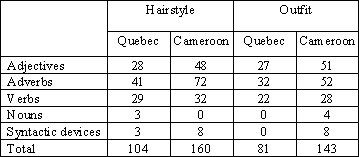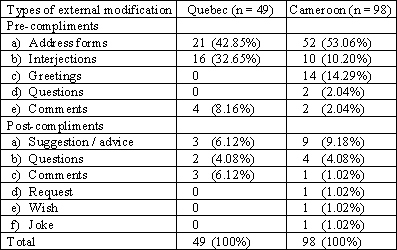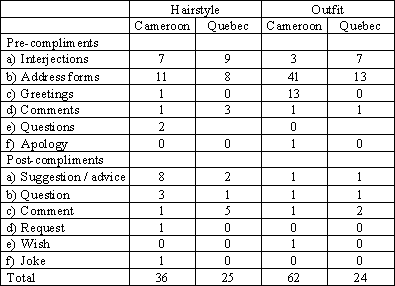(6) Mon amour, j'aime ta nouvelle coiffure, elle te va très bien. [Hairstyle, Quebec]
'My love, I love your new hairstyle, it fits you very well.'
(7) Bonjour monsieur. Vous êtes élégant dans votre nouvelle chemise et de plus elle va avec votre pantalon. [Outfit, Cameroon]
'Good morning sir. You look sharp in your new shirt and it matches your trousers.'
(8) J'aime vraiment ta coiffure tu l'as fait où. [Hairstyle, Cameroon]
'I really love your hairstyle, where did you have it done?'
4 Findings and discussion
In addition to the two strategies mentioned above (cf. Section 3.2), we will also examine the use of lexical devices (e.g. intensive adverbs as (8)) and/or stylistic devices as in (9) in the head acts. In the following examples the lexical and stylistic features are bolded.
(9) Vous êtes très joli Madame. [Outfit, Québec]
'You are very beautiful Ma'am!
(10) Je ne peux m'empêcher de vous faire part de mon admiration envers votre belle coiffure! [Hairstyle, Cameroon]
'I can't help expressing my admiration for your beautiful hairstyle!'
4.1 Frequency of the main compliment strategies
Table 1 presents the frequency of the main compliment strategies, namely 'head act(s)' (HA), and 'head act(s) + external modification' (HEM) in the two corpora.

Table 1: Frequency of the main compliment strategies in Quebec French and Cameroon French
As reported in Table 1, the Quebeckers employed more 'head act' strategies (42 of 78; (53.85%)) than the 'head act(s) + external modification' strategies (36 of 78; (46.15%)), while the Cameroonians showed more preference for 'head act(s) + external modification' combinations (64 of 107; (59.81%). Although the main compliment strategies were distributed equally in the hairstyle situation in the two data sets, there were differences in the outfit situation. In the Quebec data, the 'head act' strategies occurred much more frequently than the 'head act(s) + external modification' strategies. By contrast, the number of 'head act(s) + external modification' occurrences was more than twice that of 'head act(s)' strategies in the Cameroonian data.




